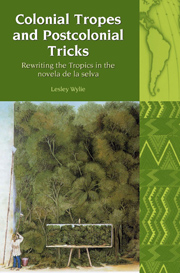Book contents
- Frontmatter
- Contents
- Acknowledgements
- Introduction
- 1 Colonial Tropes and Postcolonial Tricks
- 2 Tropical Nature and Landscape Aesthetics
- 3 Salvaging the Savage
- 4 Paradise Lost: Wilderness and the Limits of Western Escapism
- 5 Jungle Fever: Degeneration as a Trop[olog]ical Disease
- Conclusion
- Bibliography
- Index
3 - Salvaging the Savage
- Frontmatter
- Contents
- Acknowledgements
- Introduction
- 1 Colonial Tropes and Postcolonial Tricks
- 2 Tropical Nature and Landscape Aesthetics
- 3 Salvaging the Savage
- 4 Paradise Lost: Wilderness and the Limits of Western Escapism
- 5 Jungle Fever: Degeneration as a Trop[olog]ical Disease
- Conclusion
- Bibliography
- Index
Summary
Until the first decades of the twentieth century European iconography of Native Americans tended to the extremes of idealization and demonization. On the one hand, early modern commentators such as Juan Ginés de Sepúlveda considered the ‘Indians’ not only degenerate and sinful but also subhuman – a widespread belief which led to a prolonged debate in Valladolid in 1550 to determine whether Amerindians were humans or animals. On the other hand, many writers and artists located the native peoples of America in a primordial ‘golden age’ – a trend that was not discouraged by Columbus's belief that he had discovered the garden of Eden at the end of the Orinoco River, nor his founding vision of the American people as ‘desnudos como su madre los parió, y […] muy bien hechos, de muy fermosos cuerpos y muy buenas caras’. Early modern pictorial representations of American Indians, while frequently giving vent to anxieties about sexual impropriety or unrestrained cannibalism, were often guided by European concepts of beauty and morality, and depicted the Native Americans in the manner of classical statuary, with Herculean busts and flowing locks of hair. Jean de Léry's Histoire d'un voyage fait en la terre du Brésil [1578] was punctuated with flattering portraits of Amerindians, focusing on their muscular physiques and broadly European facial features. Likewise, a series of woodcuts by Hans Burgkmair from 1516–19 depicted Tupinamba Indians dressed in distinctly un-American garb and armed with swords.
- Type
- Chapter
- Information
- Colonial Tropes and Postcolonial TricksRewriting the Tropics in the novela de la selva, pp. 68 - 94Publisher: Liverpool University PressPrint publication year: 2009

